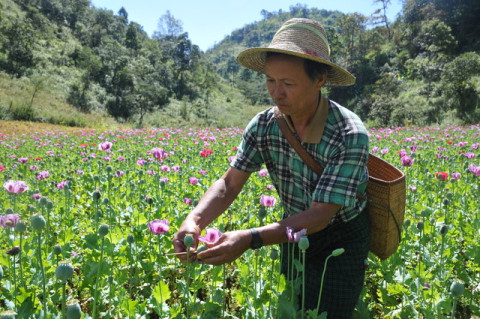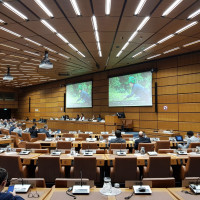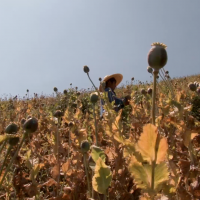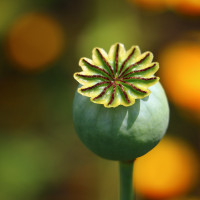Opium Farmers in Myanmar: The Lives of Producers of Prohibited Plants A Myanmar Commentary by Sai Lone
The problem of opium should not be perceived only as a simple, black-and-white, law enforcement problem. To address problems related to opium cultivation, substantial socio-economic development is required to provide meaningful alternatives for farmers, and to ensure that a humanitarian crisis will not occur as the consequence of repressive drug control policies.

Tom Kramer
Why do farmers grow opium?
This simple question requires a comprehensive and long explanation. First, we need to understand all those factors that push farmers in remote, mountainous villages to rely on income derived from opium-growing to support their families’ basic needs, health care and education for their kids.
The cultivation of opium as a cash crop seems to have entered what is present-day Myanmar from the north. Although there is no written record of how and when opium was introduced into the country, it is generally accepted that cultivation spread from the neighboring Chinese provinces. The “Opium Wars” in China (1839 – 1842) not only increased the opium demand in Chinese coastal towns, but also escalated its production in highland territories, such as Yunnan and Sichuan Provinces in China, and the adjacent Shan and Kachin States of Myanmar. By 1898, opium had become “almost the standard medium of exchange in trade” in southern Yunnan and Upper Myanmar.
Opium cash-cropping was thus introduced to Myanmar more than a century ago. Since then, the cultivation of opium has become the major livelihood of the peoples who live in the highland areas of eastern and northern Myanmar: i.e. Shan and Kachin States. The inaccessibility of these mountainous regions, combined with extreme weather, make it difficult to grow other cash crops in these areas. However, the scattered fertile spots of limestone soil in these areas are an ideal terrain for poppy cultivation.
Opium is not just a farm product that the people in remote highland areas rely upon to solve the food shortage problem, it is also a currency indispensable for their daily lives. It has become the trading medium through which they exchange for the essential necessities for them and their families, such as shelter, food, clothes, health care and even education.
The opium trade generates money for virtually everyone in the area, albeit in vastly disparate amounts. The farmers who grow the poppies earn a pittance from months of laborious work in the fields. It is other people who earn fortunes to buy houses and open shops in big cities of Myanmar as well as in neighboring countries: the merchants who buy opium from the farmers and carry it to the markets to sell; ethnic armed groups and local militias who provide security for trading routes; and corrupt law enforcement officials who close their eyes to let it happen.
Opium as a cash crop has various advantages. Although it requires more care and weeding than any other crop, once the sap has been gathered it can be kept for a long time, it is easy to store and it fetches a good price on a guaranteed market – a higher price per weight than anything else cultivated on earth. As a result, traders are prepared to travel up to the mountain villagers every year to purchase it. As opium growers often claim: “Opium doesn’t go looking for money. Money comes looking for opium.” Traders then sell rice and other commodities on credit during the off-season and collect the repayment in opium. Meanwhile, opium also functions as a general currency in the hills between villages and the members of different ethnic groups, and most things can be exchanged for it.
In addition, there are important cultural and health-related reasons for the cultivation of opium. Due to its medicinal values as an analgesic, cough suppressant and treatment for diarrhea, opium has been the main traditional medicine that villagers in the remote highland areas rely upon to cure most of their sicknesses. Furthermore, opium farmers in Myanmar not only resort to the income from opium to buy them the access to the modern health care service, they also use it to send their children to school.
In recent years, pressure from the Chinese government has led the Myanmar government to take measures against illicit poppy cultivation, and at least eradicate some of the opium fields that are located close to main roads. Some of ethnic armed groups based in the Myanmar-China borders have declared their areas of control as “Opium Free Zones”, and they have strictly enforced an opium ban. The National Democratic Alliance Army, for example, announced Mong Lar Region as “Opium Free Zone” in 1997, followed by the Myanmar National Democratic Alliance Army in the Kokang region in 2003, and the United Wa State Army in the Wa region in 2005. Their main reason for implementing these opium bans is to accommodate to drug control pressures from the international community, particularly from China. Those ethnic leaders hope that, in return for their anti-drug policy, they can whitewash their bad image as “narco-armies” and will receive more political recognition, humanitarian aid and international support to develop their war-torn and impoverished territories.
The imposition of the ban on opium cultivation, without ensuring that sustainable alternative livelihoods are in place, has been devastating for local farmers, who have subsisted on opium cultivation for generations. The ban caused serious food security problems and further limited access to healthcare and education for children. Farmers have been surviving by selling off their livestock, cutting down trees to sell as firewood, and collecting non-timber forest products. In addition, many young people have migrated to Thailand or China to work as unskilled labor for daily wages to support their families. Moreover, the opium bans and the forced eradication did not result in a reduction of opium cultivation. Instead, it created a humanitarian crisis and changed the patterns of cultivation. To grow poppy, farmers were pushed into more remote and mountainous areas where they produce two to three crops per year to compensate for their loss.
In 2013, representatives of poppy growing communities set up the Myanmar Opium Farmers’ Forum (MOFF). In its annual meetings, MOFF members share common problems and challenges, and develop recommendations and action points to further their cause. At its 6th annual forum in 2018, MOFF released a statement that raises these issues. Recently, MOFF produced the film “Opium Farmer – the lives of producers of prohibited plants in Myanmar” to raise awareness on the plight of poppy farmers and explain why people grow opium. In October MOFF also sent a short video message to a session of the Commission of Narcotics Drugs to advocate for more development-led drug control policies and for the inclusion of opium farmers in decision-making processes that affect their lives.
In conclusion, the problem of opium should not be perceived only as a simple, black-and-white, law enforcement problem. The underlying factor for opium cultivation is agriculture-based, and thus poor farmers are implicated as cultivators and producers of the raw opium. Therefore, to address problems related to opium cultivation, substantial socio-economic development is required to provide meaningful alternatives for farmers, and to ensure that a humanitarian crisis will not occur as the consequence of repressive drug control policies.
Farmers should also have the right for a meaningful involvement in the drug control policy development process as well as the right to decision-making in alternative development projects that have impact on their lives. The right sequence – development first, eradication later – is crucial: enforcement actions should only be considered after viable and sustainable livelihood alternatives are in place to achieve long-term opium reduction. Last but not least, the licit cultivation of opium for the pharmaceutical industry should not be excluded as one of the alternative options. Much more research and participatory consultations are needed to implement more effective drug control policies.



